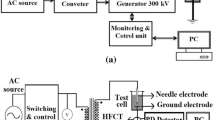Abstract
Recent concern towards environmental and fire safety of transformer operation has led to the development of natural ester based liquid insulation for power transformers. Recent advancements in nano technology confirm that the nano modified liquid insulation provides superior dielectric and thermal properties. Statistical analysis of the dielectric properties of nano modified liquid dielectrics is very important to qualify them for high voltage insulation applications. In this work, experimental works are carried out to understand the partial discharge (PD), lightning impulse (LI) and breakdown voltage (BDV) characteristics of corn oil filled with SiO2 nano fillers at different wt% concentration such as 0.01%, 0.05% and 0.1%. Needle/plane and rod/plane electrode geometry was used for creation of PD source. PD inception voltage, time domain and frequency domain characteristics of PD signals are evaluated. Weibull parameters of Phase Resolved PD pattern are evaluated. LI tests are performed at needle/plane and needle/sphere electrode geometry with standard 1.2/50 µs waveform at both positive and negative polarity. Weibull distribution analysis of LI breakdown voltage values are evaluated at different experimental conditions. BDV tests are carried out at different electrode gap distances such as 1, 2.5, 4 and 5 mm. Scale parameter and shape parameter of Weibull distribution of BDV values are computed. It is mostly observed that addition of nano SiO2 filler at lower wt% concentration in the range of 0.01–0.05% has substantial effect in enhancing the PD, LI and BDV characteristics of corn oil. Improvement in PD, LI and BDV characteristics gives confident that nano modified corn oil may be considered for outdoor transformer applications.
















Similar content being viewed by others
References
Martin N, Lelekaki N, Guo W, Odarenko Y (2011) Further studies of a vegetable-oil-filled power transformer. IEEE Electr Insul Mag 27(5):6–13
Chandrasekar S, Montanari GC (2014) Analysis of partial discharge characteristics of natural esters as dielectric fluid for electric power apparatus applications. IEEE Trans Dielectr Electr Insul 21(3):1251–1259
Rapp KJ, Corkran J, McShane CP (2009) Lightning impulse testing of natural ester fluid gaps and insulation interfaces. IEEE Trans Dielectr Electr Insul 16(6):1595–1603
Azmi K, Ahmad A, Kamarol M (2015) Study of dielectric properties of a potential RBD palm oil and RBD soyabean oil mixture as insulating liquid in transformer. J Electr Eng Technol 10(5):2105–2119
Von Thien Y, Azis N, Jasni J, Kadir MZAA, Yunus R, Ishak MT, Yaakub Z (2016) Evaluation on the lightning breakdown voltages of palm oil and coconut oil under non-uniform field at small gap distances. J Electr Eng Technol 11(1):184–191
Liu R, Pettersson LAA, Auletta T, Hjortstam O (2011) Fundamental research on the application of nano dielectrics to transformers. In: IEEE international conference, pp 423–427
Dong M, Shen LP, Wang H, Wang HB, Miao J (2013) Investigation on the electrical conductivity of transformer oil-Based AlN nanofluid. J Nanomater. Hindawi Publishing Corporation, vol 2013, Article ID 842963, pp 1–7
Ramu TS, Keshavan BK, Balasubramanya Murthi KN (2012) Application of a class of nano fluids to improve the load ability of power transformers. In: IEEE 10th international conference on the properties and applications of dielectric materials, July 24–28, 2012, Bangalore, India
Prasad D, Chandrasekar S (2017) Effect of nano SiO2 particles on partial discharge signal characteristics of FR3 transformer oil. J Adv Chem 13(5):1–10
Nagendran S, Chandrasekar S (2018) Investigations on partial discharge, dielectric and thermal characteristics of nano SiO2 modified sunflower oil for power transformer applications. J Electr Eng Technol 13(3):1337–1345
Senthilkumar S, Karthik B, Chandrasekar S (2014) Investigations on PD characteristics of thermal aged palm and corn oil for power transformer insulation applications. J Electr Eng Technol 9(5):1660–1669
Jin H, Andritsch T, Tsekmes IA, Kochetov R, Morshuis PHF, Smit JJ (2014) Properties of mineral oil based silica nanofluids. IEEE Trans Dielectr Electr Insul 21(3):1100–1108
Arvind Shriram RK, Chandrasekar S, Karthik B (2018) PD signal time-frequency map and PRPD pattern analysis of nano SiO2 modified palm oil for transformer insulation applications. J Electr Eng Technol 13(2):902–910
Du Y, Lv Y, Li C, Chen M, Zhou J (2011) Effect of electron shallow trap on breakdown performance of transformer oil-based nano fluids. J Appl Phys 110:104104-104104-4
Sankarganesh R, Shivakumar R, Chandrasekar S (2017) Study on nano-modified mineral oil surface discharge partial discharge signal characteristics for high voltage transformer applications. J Comput Theor Nanosci 14:1–8
Pompili M, Mazzetti C, Bartnikas R (2009) Comparative PD pulse burst characteristics of transformer type natural and synthetic ester fluids and mineral oils. IEEE Tran Dielectr Electr Insul 16(6):1511–1518
Martin D, Wang ZD (2008) Statistical analysis of the AC breakdown voltages of ester based transformer oils. IEEE Trans Dielectr Electr Insul 15(4):1044–1050
Li Jian, Zhang Zhaotao, Zou Ping, Grzybowski Stanislaw (2012) Preparation of a vegetable oil-based nanofluid and investigation of its breakdown and dielectric properties. IEEE Electr Insul Mag 28(5):43–50
Wang Q, Rafiq M, Lv Y, Li C, Yi K (2016) Preparation of three types of transformer oil-based nanofluids and comparative study on the effect of nanoparticle concentrations on insulating property of transformer oil. J Nanotechnol 2016:1–6
Lewis TJ (2005) Interfaces: nanometric dielectrics. J Phys D Appl Phys 38(2):202–212
Elansezhiyan A, Chandrasekar S (2017) Analysis of lightning impulse characteristics of nano SiO2 modified mineral oil for distribution transformer applications. J Comput Theor Nanosci 14:1–9
Acknowledgements
Author (S.Chandrasekar) would like to sincerely thank the Department of Science and Technology, New Delhi for providing financial support through NanoMission scheme for carrying out the research activities on nanofluid insulation for power transformer applications.
Author information
Authors and Affiliations
Corresponding author
Rights and permissions
About this article
Cite this article
Rajeswari, R., Chandrasekar, S. & Karthik, B. Statistical Analysis of Partial Discharge, Lightning Impulse and BDV Characteristics of Nano SiO2-Corn Oil for HV Insulation Applications. J. Electr. Eng. Technol. 14, 877–888 (2019). https://doi.org/10.1007/s42835-019-00095-z
Received:
Revised:
Accepted:
Published:
Issue Date:
DOI: https://doi.org/10.1007/s42835-019-00095-z




